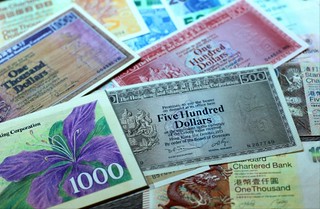
PREV ARTICLE
NEXT ARTICLE
FULL ISSUE
PREV FULL ISSUE
ARTICLE FEATURES BANKNOTE DESIGNER HENRY STEINERThe article from Hong Kong features a designer of that country's banknotes, a native of Vienna, Austria. -Editor
Besides many famous logos, including those of HSBC, the Hong Kong Jockey Club, Wellcome, Hongkong Land and Lane Crawford, he has designed the banknotes issued by Standard Chartered Bank since late 1979, after earlier designing notes for HSBC. Hong Kong allows the three note-issuing banks - HSBC, Standard Chartered and Bank of China (Hong Kong) - to appoint the designers for their notes. Steiner was born in Vienna, Austria, in 1934 and moved to New York with his parents to escape Nazi persecution. He came to Hong Kong in 1961 to work for a magazine on a nine-month contract but fell in love with the city. He stayed and developed his career here for 54 years, also marrying and having two sons. Steiner initially studied painting but later shifted to design, which he said was a better fit. "A painter tries to solve his own problems while a designer tries to solve the clients' problems," he said. "I kind of like to help other people solve their problems, so design suited me better." Steiner said the process of designing a banknote was no different from other corporate design work, with the first step being to talk with the bank's top executives to know what message they wanted to send out through the banknotes. "They generally would like to have their corporate image as well as the image of Hong Kong and its culture reflected in the banknote's design," he said.
His Standard Chartered banknote designs have been updated several times but have always featured five animals from Chinese mythology, a theme he is very proud of, believing they add character to the banknotes. There is a clear hierarchy. The more important the note, the more important the animal. There is a fish on the HK$20 note, a turtle on the HK$50, a chi lin (unicorn) on the HK$100, a phoenix on the HK$500 and a dragon on the HK$1,000 note. "However, people should remember the Chinese legend that when a fish jumps over the gate, it becomes a dragon. I like all my banknote designs, but I like the HK$20 fish the most as the fish could become a dragon one day," he said. The reverse side of the current series of banknotes features a theme combining Chinese heritage with new technology, which Steiner said showed Hong Kong as a city where East meets West. In 2009, Steiner also designed a special HK$150 banknote issued to celebrate Standard Chartered Bank's 150th anniversary in Hong Kong. That note did not feature an animal, but instead a mix of people representing the city. To read the complete article, see: Wayne Homren, Editor The Numismatic Bibliomania Society is a non-profit organization promoting numismatic literature. See our web site at coinbooks.org. To submit items for publication in The E-Sylum, write to the Editor at this address: whomren@gmail.com To subscribe go to: https://my.binhost.com/lists/listinfo/esylum All Rights Reserved. NBS Home Page Contact the NBS webmaster 
|

